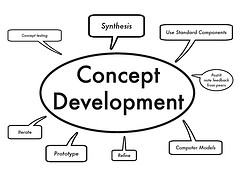|
|
|
Tuesday, February 5th, 2019

Two facts
- Google hires a lot of people
- Google is very good at algorithms
So why not use the latter to solve the former?
It doesn’t work.
Google is known for hiring really smart people, so why not use brain teaser questions to identify them.
It doesn’t work.
Analytics can make a difference if your company is large enough.
AI may help, but its bias, the result of biased data sets, means a high cost in missed candidates.
It also means more time to hire and more money spent, because you will be chasing the same people as everyone else.
Like it or not, your staffing is dependent on the hiring skills of your managers.
There is no staffing gene; people aren’t born knowing how to hire anymore than they are born knowing how to manage.
It’s your responsibility to make sure they learn both.
Image credit: Otota DANA
Posted in Ducks In A Row, Hiring | No Comments »
Monday, September 24th, 2018

Poking through 11+ years of posts I find information that’s as useful now as when it was written.
Golden Oldies is a collection of the most relevant and timeless posts during that time.
You can not imagine the thrill when I see the stuff I passionately believe in mirrors the beliefs of people I hold in high regard, such as Fred Wilson, who knows and has experienced far more than I ever will. It’s a definite high.
Read other Golden Oldies here.
A few days ago Fred Wilson wrote about the importance of culture and fit.
Some entrepreneurs and CEOs buy into “hire the best talent available” mantra. That can work if everything goes swimmingly well. But as I said, it often does not, and then that approach is fraught with problems. The other approach is hire for culture and fit. That is the approach I advocate.
That’s the same approach I’ve advocated for decades.
What many forget is that “the best talent available” refers to whoever will perform best in your culture as part of your team and focus on your company’s success.
Too many founders, CEOs, other execs and even lower level managers seem to hire for bragging rights instead.
I wrote about hiring and culture here last Sept and included a link to an article I wrote for MSDN way back in 1999 that explained how to use your culture as a screening tool when hiring.
I’ve always told clients that the fastest way to success is to always hire the right person at the right time and for the right reasons.
Good hiring is like cooking Chinese—80% of the time used is spent prepping and the balance doing.
There really are no shortcuts; especially not hiring other people’s stars.
Not to sound self-serving, but I’ve been surprised at how closely the ideas I’ve always believed in parallel Wilson’s thoughts.
Image credit: HikingArtist
Posted in Golden Oldies, Hiring | No Comments »
Friday, September 21st, 2018

A Friday series exploring Startups and the people who make them go. Read all If the Shoe Fits posts here.
The mindset many founders look for. Sadly, they aren’t the only ones.

Can AI analyze MAP as well it does other qualifications?

Image credit: HikingArtist, Unknown, very old Dilbert
Posted in Hiring, If the Shoe Fits | No Comments »
Wednesday, November 8th, 2017

Yesterday we looked at some terrible management advice; today we’ll check out the unstated, totally ignored elephant in the room when it comes to hiring.
When AI tells you the success of your new hire, before you hire them is a typical misleading media headline.
While the experts talk about the enormous amount of candidate data available online that goes way beyond education, skills, experience and even background checks, and AI’s ability to correlate and to some extent, interpret it, they agree that it still requires human involvement.
But comprehending someone’s motivations and soft skills – attentiveness, nimbleness or assertiveness — requires a level of interpretation that some recruiters don’t believe machines have just yet. (…)
That type of intuition is already being built into machines. In the hiring process, the data to analyze is flooding in and it will require powerful and intelligent machines to digest it all; companies are realizing they need to be more precise about their hiring needs in order to get answers from machines; and already we’re seeing some machines conduct simple tasks, such as administrative matching.
Once again the elephant is ignored.
All focus is on candidates, while the elephants are completely ignored.
What are the elephants?
The manager and the culture they create in their individual domain all the way down to a team leader.
That’s why the person who soars as a star working for X can easily burn out and crash after going to work for Y and vice versa.
The elephants aren’t new; they’ve always been around and even occasionally written about, but rarely credited with candidate success or failure.
Will/can AI change that?
Unlikely, because, as seen in hundreds of examples, self-analysis is rarely accurate and how someone wants to be managed is not necessarily predictive of how they will manage others.
So, as long as the elephants continue to roam and thrive, it remains unlikely that AI will actually be able to predict hiring success.
Image credit: David Blackwell
Posted in Culture, Hiring, Personal Growth | No Comments »
Tuesday, October 13th, 2015

Hiring is as much art as science.
It’s a fact that the data-driven really hate.
Such as Google, which hires hundreds of people every week..
It used to hire only candidates with 3.7+ GPA, double 800 SAT scores and world-class interviewing skills — But those criteria weren’t accurate at predicting success in the Google world.
In 2007 it developed an algorithm to screen candidates — it didn’t work.
More recently, Google’s brain-teaser questions garnered a lot of attention, but they don’t work, either.
“Everyone likes to ask case questions and brain-teasers. It turns out our data shows that doesn’t actually predict performance. There’s no correlation with your ability to do that,” said Laszlo Bock, Google’s SVP of People Operation.
Anallytics can do an amazing job if the company is large enough to develop valid data points.
“Once you get through all the noise and beliefs that people have, and identify that right profile, you can have some solid impact in your organization,” Ryan Dullaghan, Jet Blue’s manager of people assessment and analytics, noted. He described the measurable benefits for the company that have resulted from “really focusing on fit for the job, “including higher employee engagement and retention, and a 12% decrease in total absences.”
Those are significant numbers.
But what do you do if you don’t have access to viable analytics, whether because of size, money or senior management apathy?
Start by developing a written set of questions (see the article for ideas) that you ask your own people.
Crunch the responses to get a general company profile.
Then make it a habit to ask them of all candidates (no matter the position, along with the position-specific questions.
The one caveat to always remember is that while some people are expert at acing questions/tests, others are the opposite, so don’t treat that as make or break criteria.
More on hiring tomorrow.
Flickr image credit: jphilipg
Posted in Ducks In A Row, Hiring | 1 Comment »
Thursday, May 7th, 2015
 Years ago, Neil Senturia, CEO of Black Bird Ventures posted his thoughts about CEOs, hiring and culture. Years ago, Neil Senturia, CEO of Black Bird Ventures posted his thoughts about CEOs, hiring and culture.
“Building a team is the key to creating a successful start up—picking the people who will fit into the culture. The CEO’s most important job is hiring well and being the visionary and model for the culture that you want in your company. There are great players but what wins Super Bowls are great teams.’
While everyone talks about building teams, the importance of teams, etc., bosses continue to hire skill sets without enough thought or rationalizing as to whether the candidates possessing them fit the culture.
It often takes the threat of a team revolt to force them to pass on candidates with great skills who obviously don’t fit.
Culture is high enough on the radar now that most entrepreneurs know that the wrong hire can derail their culture, but they still have a problem passing on badly needed skills.
It still takes guts to make the correct decision for the long-term in a world that runs on short-term.
It’s never an easy choice, but it is one that will pay off for years to come.
I wrote Don’t Hire Turkeys! Use Your Culture as an Attraction, Screening, and Retention Tool and Turkey-Proof Your Company 15 years ago and it’s just as true today as it was then.
Your culture is the sieve through which all people should pass—without contortions or rationalizations—preferably aligned with and passionate about it, but at the very least synergistic.
The keynotes of a culture are:
- Consciously developed – Cultures happen with or without thought. Those that just happen are the easiest to twist and manipulate.
- Flexible – Just as trees bend in strong winds and buildings are designed to sway in an earthquake, so you want to build your culture to withstand pivots, economic storms and the winds of change.
- Scalable – To grow as the company grows requires a deep understanding of the values that are cultural bedrock vs. trim and accessories.
- Sustainable – Although originally stemming from the CEO, at some point the culture must become the property of the employees if they’re going to support it.
None of this predicts what the culture will actually be, that’s a function of the CEO’s values and MAP (mindset, attitude, philosophy)™.
The important point here is to hire with your eyes wide open, so you don’t end up with a round peg trashing your square hole.
Posted in Culture, Entrepreneurs, Hiring | 1 Comment »
Tuesday, April 28th, 2015

Considering all the hand-wringing and diverse efforts to attract women to tech, it turns out that it’s relatively simple.
Lina Nilsson is a Ph.D. in biomedical engineering and director of innovation at the Blum Center for Developing Economies at UC Berkeley, noticed a quaint factoid.
…if the content of the work itself is made more societally meaningful, women will enroll in droves. That applies not only to computer engineering but also to more traditional, equally male-dominated fields like mechanical and chemical engineering.
This held true at dozens of universities, such as D-Lab at MIT, Arizona State University, University of Minnesota, Pennsylvania State University and Santa Clara University.
And it’s important to recognize that the primary, or even secondary, intent was not to attract women, but to solve problems.
None of the programs, clubs and classes were designed with the main goal of appealing to female engineers, and perhaps this is exactly why they are drawing us in. At the core of each of the programs is a focus on engineering that is cutting edge, with an explicit social context and mission.
The problem, of course, is that most existing companies and current startups are focused on money, while “women seem to be drawn to engineering projects that attempt to achieve societal good.”
Higher purpose vs. greed says it all.
Image credit: Kurt Bauschardt
Posted in Change, Ducks In A Row | No Comments »
Thursday, April 16th, 2015

Last Friday I shared my response to a founder who was having difficulties closing desirable candidates and touched on the need for a good hiring process; here is the information needed to create one for you company.
Key points to remember,
- process is good;
- bureaucracy is bad;
- authentic, transparent communications are the basis of good process
While a good hiring process is necessary, it is often one of the first to ossify into bureaucracy.
A good hiring process is
- transparent and painless for the candidate, and
- simple, easy to use and painless for the hiring manager.
But why a process? Why take the chance on creating something that so often turns into a bureaucratic nightmare? Why not just grab ‘em when you find ‘em?
Because you need a repeatable procedure that allows for the orderly acquisition of people, so the company can plan for and support its growth and, more importantly, land the candidates you want.
A good hiring process removes chaos and allows speed in staffing.
The best hiring process is flexible and, although based on a set of fixed principles, constantly re-invents itself based on changes in the real world.
Speed is the key.
Without question speed is the most effective, least expensive of all hiring practices.
This means there must be speed at all points of the process—any delays should originate only from the candidate.
Speed is key because people tend to judge what it will be like to work for a company/manager by how they are hired.
If the process is fast, smooth, and enjoyable, they will assume that decisions are made speedily, the company has little bureaucracy, and that working there will be fun—and they are usually right.
And vice versa.
Here are the basics of a good hiring process:
- The company’s operating plan and budget are the basis of the staffing plan.
- Know exactly what the job entails, what authority it has, and how it interacts with the team and outside departments, customers, vendors, etc.
- Based on number two, write a complete req and hire the first person who meets its minimum requirements (see Req or Wreck in the right frame).
- Be flexible and creative when sourcing.
- Involve your people.
- Interviews should be as culturally-relevant as they are work-relevant.
- Always sell the meat (projects, growth opportunities, chance to contribute and make a difference) as opposed to focusing on dessert (perks, money)
Do’s:
- Do create a positive experience for both the hire-ees and hire-ers.
- Do use multiple interviewers—they are harder to con
- Do have a well-understood set of components including: media spending, recruiter use, relocation, sourcing, resume evaluation, scheduling, interviewing, negotiating, cutting and extending offers, closing candidates, deflecting counter offers, and pre-start actions in your hiring process as well as a flexible way to deal with each.
- Do make sure that sourcing and headhunter policies reflect both company needs and the current labor market.
Don’ts:
- Don’t “figure out” what you need by interviewing multiple candidates.
- Don’t keep interviewing candidates in the hopes of finding one who embodies your entire wish list.
- Don’t assume using a headhunter will automatically reduce your time and work.
- Don’t have a start and stop hiring process—whether from whimsy or human bottlenecks.
- Don’t buy people; those who join only for the money/perks/stock will leave for more money/perks/stock.
When all is said and done, the true purpose of a hiring process is to help the company compete for talent, which, in turn, allows the company to compete for customers.
Image credit: Jordanhill School D&T Dept
Posted in Entrepreneurs, Hiring | No Comments »
Wednesday, October 15th, 2014
 When filling an opening do you look for primarily for world-class skills? When filling an opening do you look for primarily for world-class skills?
Do you long for the person who can ‘hit the ground running’ with little-to-no time or assistance needed to come up to speed?
Are your hires generally successful in both productivity and longevity?
If your response isn’t an unqualified ‘yes!’ then maybe you’re ignoring the most important factor.
Attitude, which translates to cultural fit.
Or, as David Ogilvy puts it, hire for the 3 P’s philosophy: Performance, Promotability and Potential
By the same token, the hottest candidates don’t always grab for the biggest bucks or need to be the biggest frog in the pond; there are intangibles that resonate on a purely personal level.
Every boss craves a world-class team.
Every candidate wants to play on one.
World-class is achieved most quickly when attitudes align.
Flickr image credit: Alex Giraldez
Posted in Culture, Hiring | No Comments »
Friday, October 10th, 2014
A Friday series exploring Startups and the people who make them go. Read all If the Shoe Fits posts here
 As the importance of culture in startups becomes ever more obvious, founders are faced with this question. As the importance of culture in startups becomes ever more obvious, founders are faced with this question.
“How do we keep our corporate culture as we grow?”
The answer is “Through a lot of hard work and tough hiring decisions.”
There are no shortcuts; no easy way; no app for that.
Unfortunately, that’s not an answer many founders want to hear—or do.
First, you have to clearly identify absolute company values—those with no wiggle room—which takes time and effort.
Next, it means interviewing far more candidates than when all that matters are skills.
Finally, it takes the toughness to walk away from sometimes dazzling candidates who, no matter how brilliant and skilled they are, just don’t fit.
It’s far easier to teach a skill than instill/change values and/or attitude.
So the next time you find yourself in this situation stop and think—is it worth selling your company’s culture down the river just to avoid more interviewing.
It’s your choice, but everyone will end up sleeping in the bed you choose to make.
Image credit: HikingArtist
Posted in Culture, Hiring, If the Shoe Fits | No Comments »
|
 Subscribe to
Subscribe to
MAPping Company Success
About Miki 
Clarify your exec summary, website, etc.
Have a quick question or just want to chat? Feel free to write or call me at 360.335.8054
The 12 Ingredients of a Fillable Req
CheatSheet for InterviewERS
CheatSheet for InterviewEEs™
Give your mind a rest. Here are 4 quick ways to get rid of kinks, break a logjam or juice your creativity!
Creative mousing
Bubblewrap!
Animal innovation
Brain teaser
The latest disaster is here at home; donate to the East Coast recovery efforts now!
Text REDCROSS to 90999 to make a $10 donation or call 00.733.2767. $10 really really does make a difference and you'll never miss it.
And always donate what you can whenever you can
The following accept cash and in-kind donations: Doctors Without Borders, UNICEF, Red Cross, World Food Program, Save the Children
*/
?>About Miki
About KG
Clarify your exec summary, website, marketing collateral, etc.
Have a question or just want to chat @ no cost? Feel free to write
Download useful assistance now.
Entrepreneurs face difficulties that are hard for most people to imagine, let alone understand. You can find anonymous help and connections that do understand at 7 cups of tea.
Crises never end.
$10 really does make a difference and you’ll never miss it,
while $10 a month has exponential power.
Always donate what you can whenever you can.
The following accept cash and in-kind donations:
|










 Years ago, Neil Senturia, CEO of Black Bird Ventures posted his thoughts about CEOs, hiring and culture.
Years ago, Neil Senturia, CEO of Black Bird Ventures posted his thoughts about CEOs, hiring and culture.

 When filling an opening do you look for primarily for world-class skills?
When filling an opening do you look for primarily for world-class skills? As the importance of culture in startups becomes ever more obvious, founders are faced with this question.
As the importance of culture in startups becomes ever more obvious, founders are faced with this question.
